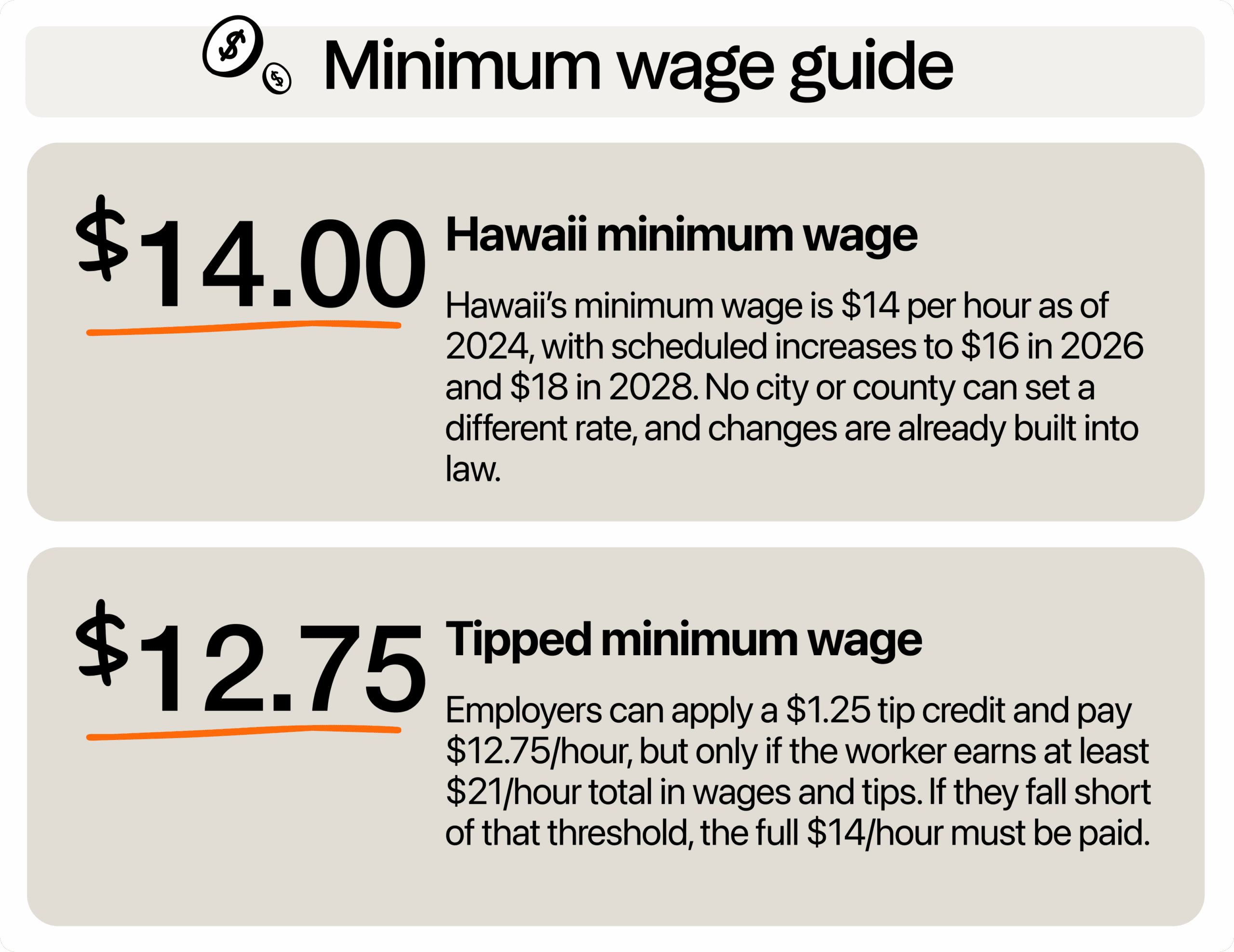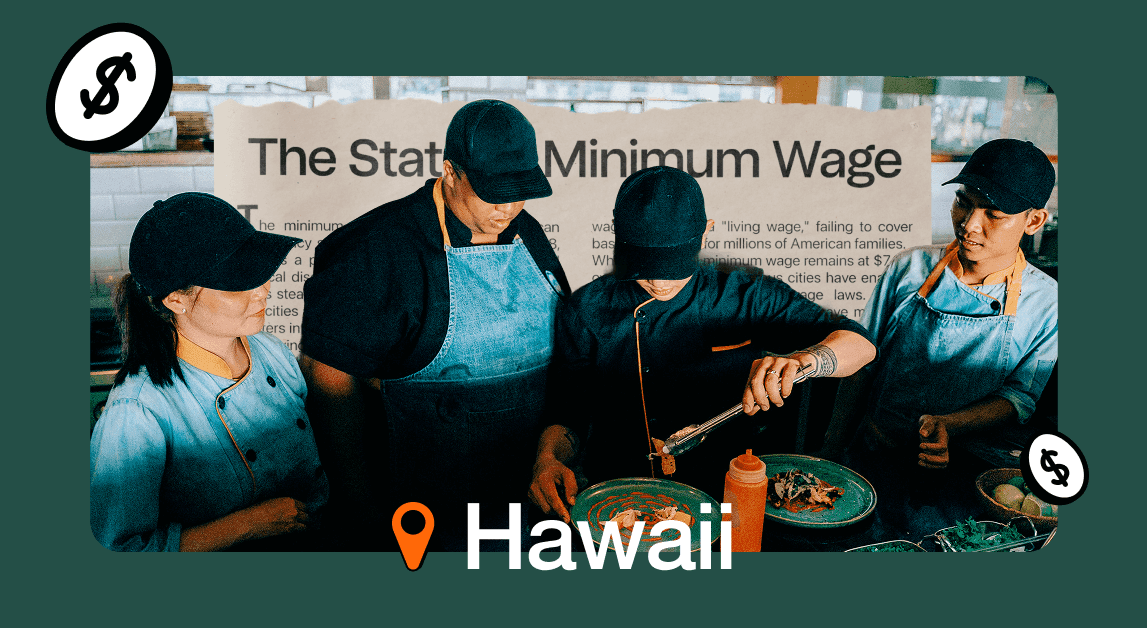With Hawaii’s minimum wage climbing and the cost of living higher than ever, restaurants can’t afford to operate on autopilot. Running a lean, profitable business today means rethinking how you schedule your staff and structure your day-to-day operations. From boosting high-margin sales to reducing labor waste, small changes can make a big difference.

What’s the minimum wage in Hawaii?
As of January 2024, Hawaii’s minimum wage is $14 per hour, higher than the federal baseline of $7.25 per hour. This latest minimum wage applies statewide, meaning no county or city can set a different rate. That puts Hawaii among the highest-paying states in the nation, with only a few like Washington and California having higher minimum wage rates.
Looking ahead, the law schedules a wage increase to $16 per hour in 2026 and to $18 per hour by 2028 under current labor standards.
Is there a law to increase Hawaii’s minimum wage in 2025 and beyond?
Hawaii passed Act 114 in 2022, which sets a clear, phased plan to raise wages. Starting at $12 per hour, the minimum wage automatically increases by $2 after two years, ending in 2028.
The legislature said the staged increases help families keep pace with rising costs after the pandemic. At the same time, it gave small business owners enough time to adjust to paying higher wages.
But there’s a potential change on the horizon. In January 2025, lawmakers introduced House Bill 524, which proposed to cap the 2026 rate at $15 per hour instead of $16. It also suggested raising the tip credit early to $1.50 per hour and lowering the earnings threshold for tipped workers from $7 above minimum to just $0.50 above.
Hawaii’s business groups support it, saying it helps small businesses manage labor costs. On the other hand, state worker advocates argue it limits support for lower-wage workers and widens income gaps.
As of this writing, the bill’s future remains uncertain. Until HB524 becomes law (or not), restaurant businesses in the state should prepare for both scenarios by updating labor budgets and wage standards.
Special Hawaii wage rules
One of the special Hawaii wage laws you should understand is for tip credits. You can apply a $1.25 tip credit and bring the base wage down to $12.75 per hour as long as the tips make up the difference.
But there’s a catch: Your tipped workers must earn at least $21 per hour total (wages + tips) for the credit to apply. That’s one of the highest thresholds in the country. If their tips fall short, you’re required to pay the difference.
For 2026, tip credit may stay at $1.25, with tipped employees needing to earn a total of $23 per hour, or it may rise to $1.50 if HB524 passes. Then, two years later, tipped employees must earn at least $25 per hour total.
If a server earns $12.75 per hour in wages and brings in just $7 in tips per hour. That’s only $19.75 per hour, which is below the threshold, so you can’t apply for the tip credit. You’d owe them the difference.
You can pay below the Hawaii minimum as well. For instance, full-time students and apprentices or trainees can be paid below $14 per hour as long as they pass the requirements from the Department of Labor.
Take note, though, that exemptions don’t mean you can cut corners. Hawaii minimum wage laws still require overtime pay at 1.5x after 40 hours per week, as well as meal and rest breaks for younger workers.
Hawaii cost of living vs living wage gap
As of 2025, Hawaii has the highest cost of living with an index of 186.9. This is nearly 87% higher than the national average, making it difficult for residents to purchase daily essentials comfortably. Housing costs are even more dramatic, with a housing index of 310, meaning rent in Hawaii is more than three times the national level.
To afford a studio unit, workers need $31.59 per hour, and for a one-bedroom, that jumps to $34.22 per hour. Even with the law that automates wage increase, there’s still a huge deficit. In fact, workers need to work at least 98 hours to be able to afford a one-bedroom rental with the current minimum wage.
When wages don’t cover basic expenses, your team feels it. Employees juggle multiple jobs, making staffing unpredictable. That leads to higher shift cancellations, burnout, and, ultimately, higher turnover. In turn, you face increased training costs and a hit to service quality.
As a business owner, you must offer fair wages and flexible scheduling to keep shifts fully staffed and avoid hiring churn. Consider implementing performance bonuses to help offset the high living costs while maintaining employee morale.
How businesses can adapt without burning out their budget
Rising wages don’t have to wreck your bottom line. With the right strategies, you can stay compliant and stay profitable, without overloading your team or passing every cost onto customers.
Promote high-margin items
Start by analyzing which dishes sell well and bring in profit. These are items that require less labor and ingredient costs. For instance, pasta dishes often have high margins because ingredients are cheap and preparation is quick. Cocktails and specialty drinks also provide good profit potential.
Then, use menu engineering to spotlight these items. Place them in the upper right corner or center, which are considered “golden spots” where customers’ eyes naturally land. Add a box, icon, or callout like “Chef’s Pick” or “Most Popular” to draw attention without being pushy.
Make sure the description is appealing too. Use sensory words like “creamy,” “crispy,” or “fire-grilled” to help the item stand out and sound irresistible.
Next, consider pricing strategies that boost perceived value. Instead of listing prices in a straight column, tuck them at the end of the description so customers focus more on the dish itself. Avoid using dollar signs, as they can trigger price sensitivity.
You can also bundle high-margin items with popular sides or drinks to build meal combos that seem like a deal but actually drive more profit. Tweaking your menu can help increase profits by 10% to 15% regularly.
Cross-train staff to reduce gaps
Cross-training helps your team fill in where needed and cuts down on extra hires. 68% of restaurants already use this as a key labor strategy, making
“I would rather pay a person 20 an hour that knows three stations and is a good salesperson than pay someone 15 an hour that knows one station and doesn’t sell,” Restaurant consultant Jim Taylor noted in our restaurant labor costs playbook.
A well-trained FOH staffer who can jump on the bar or host stand means smoother shifts and fewer labor surprises. It also boosts morale when employees learn new skills.
To start cross-training, identify which roles overlap or experience the most downtime. For example, train bussers to host during slower periods or teach servers how to handle basic expo tasks when the kitchen gets slammed.
Build training into slower shifts or use short daily “huddles” to cover one skill at a time. Keep things hands-on and shadow-based since people learn faster when they watch someone do the task in real time.
It’s also best to focus first on your most reliable team members, then expand training across your FOH and BOH as you go. Make sure to track who’s trained on what. Use a simple skills matrix or checklist to see where your coverage is strong and where you still have gaps.
Cross-training shouldn’t feel like extra work. It should feel like growth. Recognize staff who take on new responsibilities and offer small incentives like preferred shifts, raises, or bonuses. When your team knows they’re gaining skills and getting rewarded, they’re more likely to step up and stay.
Rethink split shifts and downtime
Split shifts may look cost-effective until you consider low morale and no-shows. Instead, structure shifts around busy periods and avoids long idle time.
First, check your sales and labor data to identify slow periods and peak hours. Once you have that information, you can consider the different types of work schedules and find one that matches your business needs.
For example, rather than scheduling one server from 10 a.m. to 3 p.m. and again from 6 p.m. to 10 p.m., consider overlapping shorter shifts, like 11 a.m. to 4 p.m. and 5 p.m. to close. You can then work around their days off so they can get a full day’s rest or two to pursue other opportunities or personal commitments.
You can also fill downtime with tasks that add value without overloading your staff. Think side duties like folding napkins, updating inventory, or prepping ingredients. Or let team members opt into optional hours for upselling training or team-building activities.
If you must use split shifts, make sure staff agree to it in advance and offer perks like shift meal credits or guaranteed hours. The goal is to keep shifts predictable and fair, so your team feels respected and your restaurant runs like clockwork.
Ride the wage tide smoothly
Staying ahead of the rising minimum wage in Hawaii (and cost of living) means understanding the wage law and making your operations more efficient. Employers must focus on creating a supportive work environment that values their greatest asset: their team. As a result, success will surely follow.
Use restaurant scheduling software to assign shifts easily and track hours automatically. Create flexible, efficient schedules that minimize labor costs while keeping your team motivated and engaged.

Rebecca Hebert, Sales Development Representative
Rebecca Hebert
Sales Development Representative
Rebecca Hebert is a former restaurant industry professional with nearly 20 years of hands-on experience leading teams in fast-paced hospitality environments. Rebecca brings that firsthand knowledge to the tech side of the industry, helping restaurants streamline their operations with purpose-built workforce management solutions. As an active contributor to expansion efforts, she’s passionate about empowering restaurateurs with tools that genuinely support their day-to-day operations.
